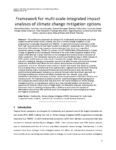Use este identificador para citar ou linkar para este item:
http://www.alice.cnptia.embrapa.br/alice/handle/doc/959735| Título: | Framework for multi-scale integrated impact analyses of climate change mitigation options. |
| Autoria: | PÉREZ-SOBA, M.  PARR, T.   WINOGARD, M.   CLAROS, M. P.   VARELA-ORTEGA, C.   ASCARRUNZ, N.   BALVANERA, P.   BHOLANATH, P.   EQUIHUA, M.   MARTORANO, L. G.   JONES, L.   MAASS, M.   THONICKE, K.   |
| Afiliação: | Marta Pérez-Soba; Terry Parr; Manuel Winogard; Marielos Pena Claros; Consuelo Varela-Ortega; Nataly Ascarrunz; Patty Balvanera; Pradeepa Bholanath; Miguel Equihua; LUCIETA GUERREIRO MARTORANO, CPATU; Laurence Jones; Manuel Maass; Kirsten Thonicke. |
| Ano de publicação: | 2013 |
| Referência: | In: INTERNATIONAL CONFERENCE ON CLIMATE CHANGE EFECTS, 2013, Potsdam. Impacts world 2013. [Potsdam: Potsdam Institute for Climate Impact Research], 2013. |
| Conteúdo: | Tropical forest ecosystems are hotspots for biodiversity and represent one of the largest terrestrial carbon stocks, making their role in climate change mitigation (CCM) programmes increasingly important (e.g. REDD+). In Latin America these ecosystems suffer from high land use pressures that have resulted in a dramatic biodiversity loss. Little is known about how CCM options may impact on biodiversity and how this in turn may affect ecosystem carbon storage. Within this context, the FP7 ROBIN (Role Of Biodiversity In climate change mitigatioN) project developed a framework for multi-scale integrated analysis of the impacts that land use change may have on the ecological and social-economic processes of these ecosystems. The framework represents a continuous feedback loop in which changes in CCM options modify land use, that results in biodiversity change, affecting ecosystem functions, leading to changes in ecosystem services that affect human outcomes and societal behaviour, and which then affect the main drivers and pressures on biodiversity and ecosystems, and so on. We have constructed an indicator framework that allows to quantify, link and assess these interactions at three spatial scales: regional (Central and South America), national (Bolivia, Brazil, Guyana and Mexico) and sub-national (study sites representing multifunctional landscapes). Indicators are selected through a demand-driven approach, by directing modelling and assessment efforts towards end-user relevant issues using stakeholder participatory processes. Indicator values are grounded on field data, statistics and model outputs. The framework provides a basis for understanding potential tipping points and unexpected consequences that may arise from the implementation of climate change mitigation policies, or management options (e.g. reducing deforestation and burning, or expansion of areas of biofuel crops in illegal areas) . An illustrative example, showing how the framework helps to identify the appropriate indicators to synthesise the impacts of afforestation (one of the CCM options) across the ecological and socio-ecological processes and regions is presented |
| Thesagro: | Biodiversidade Ecossistema Floresta Tropical Mudança Climática |
| Tipo do material: | Artigo em anais e proceedings |
| Acesso: | openAccess |
| Aparece nas coleções: | Artigo em anais de congresso (CPATU)  |
Arquivos associados a este item:
| Arquivo | Descrição | Tamanho | Formato | |
|---|---|---|---|---|
| cwiperezsoba.pdf | 738,92 kB | Adobe PDF |  Visualizar/Abrir |









